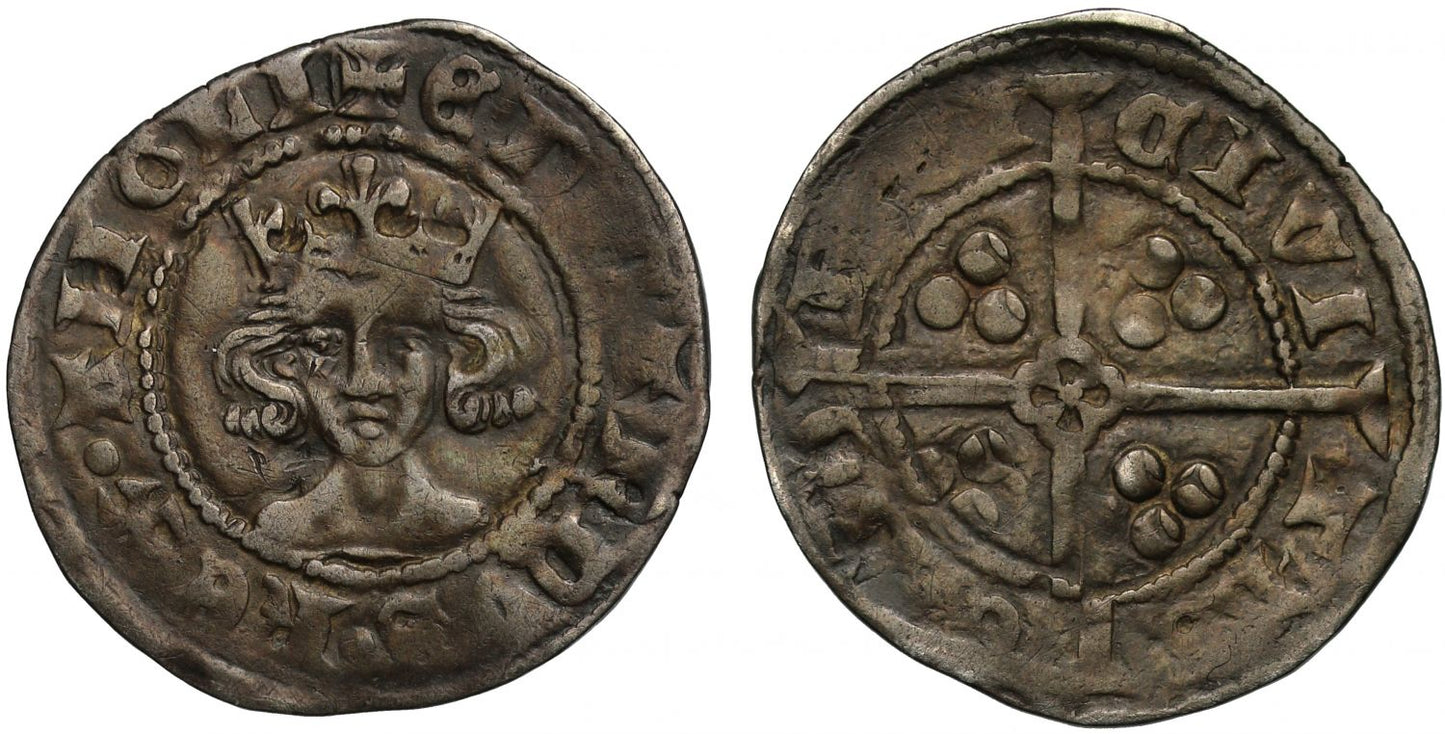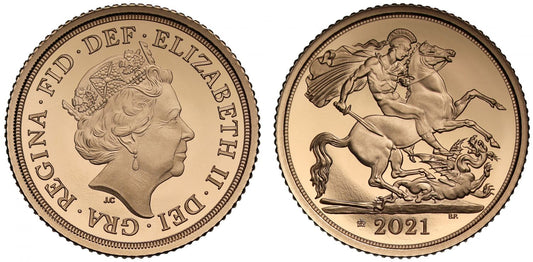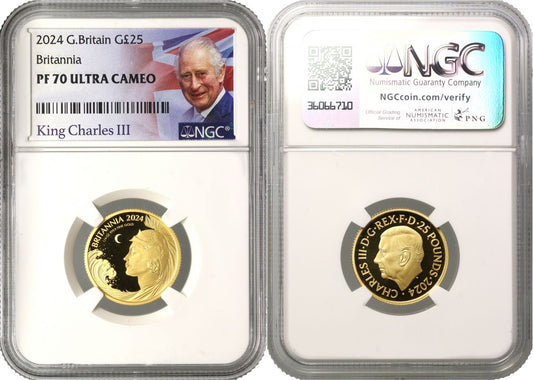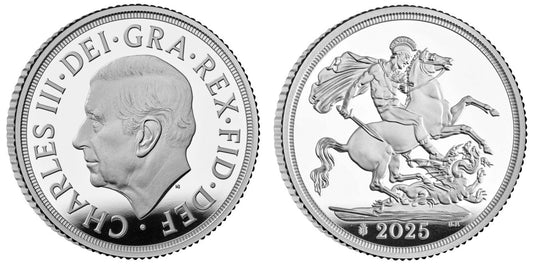FAQs
What makes a coin valuable?
I have coins to sell, what’s the next step?
How will my purchases be shipped?
What happens if I’m not entirely happy with my purchase?
Edward III Penny, Treaty period, York Mint, under Archbishop Thoresby
Edward III (1327-77), silver Penny, Treaty period (1361-69), York Mint, issued under Archbishop Thoresby, facing crowned bust beaded circles and legend surrounding, rounded letters with lombardic n and annulet stops, +EDWARDVS. REX. AnGLI, rev. voided quatrefoil at centre of long cross, tri-pellets in each inner angle, beaded circles and legend around with barred A, CIVI TAS EBO RACI, weight 1.08g (N.1268; S.1630). Toned, weakly struck in parts, very fine with a decent portrait.
The Latin abbreviated legend translates as "Edward, King of the English" and on the reverse "City of York."
John Thoresby was appointed Archbishop of York on the 16th August 1352, having been Chancellor of England since 1349. He was later made a Warden of the Cinque Ports in 1355; but resigned the great seal in 1356 so he could focus on his northern interest, to bring new order and discipline and commence much building work at York Minster. He died at Cawood Yorkshire on 6th November 1373.
One of the longest reigns of the medieval period Edward III born 13th November 1312 as Edward of Windsor came to power aged 14 after his Father was forced to relinquish the crown by his Mother and he was coronated on 1st February 1327. Edward married Philippa of Hainault on 24th January 1328 at York Minster and they had five sons and four daughters. His Father passed away suspiciously whilst imprisoned at Berkely Castle on 21st September of 1327 but young Edward waited until he was 17 before leading a successful coup d'etat on 19th October 1330 against Roger Mortimer the lover of his mother and de facto ruler whom he had executed. Next English magnates known as "The Disinherited" having lost land in a peace accord invaded Scotland and won a victory at the Battle of Dupplin Moor in 1332 and attempted install Edward Balliol the son of John Balliol on the throne in lieu of the infant David II. Balliol was soon expelled and seeked the help of Edward who then won a decisive victory at Berwick reinstalling Edward Balliol and giving Edward III swathes of land in southern Scotland. However this was short lived and David II's forces regained control by 1338. Meanwhile Philip VI in France confiscated the Duchy of Aquitaine and the county of Ponthieu. Therefore Edward III declared himself rightful heir to the French throne as grandson of Philip IV in 1337 sparking off the Hundred Years War, and after some initial teething troubles the first phase went well for England with the naval victory at Sluys on 24th June 1340 being decisive, supposedly influencing the design of the gold Noble. This was followed by other major land victories at Crecy on 24th August 1346 and the Battle of Poitiers won by his son Edward the Black Prince on 19th September 1356, all of which led to the Treaty of Bretigny drafted on 8th May 1360 and ratified on 24th October as the Treaty of Calais, giving large territorial gains if Edward renounced his claim to the French throne. However, the relative peace that followed did not last long and by 1369 the French war commenced again and son of Edward III, John of Gaunt led a military campaign which failed and led towards the 1375 Treaty of Bruges which reduced the lands to only Calais, Bordeaux and Bayonne. These battles and campaigns were all played out against a backdrop in England of the spread of plague known as the "Black Death" leading to labour shortages and led to the adoption of the "Statute of Labourers" in 1351 which ultimately failed. Edward's wife Phillipa died on the 15th August 1369 from illness similar to edema at Windsor Castle. Directly connected to the continued military activity a great deal of taxation occurred which led to political discontent, though the King always remained popular publicly. The politics came to a head in 1376 with the "Good Parliament where grievances were aired dismissing varied advisors from their positions and the banishment of Edward's mistress Alice Perrers who was wielding far too much influence over the aged King who was becoming incapacitated by illness. Edward III signed letters patent for the succession of the crown and in late September he fell ill from a large abscess. He rallied a little in the coming months from February 1377 but later descended in health into early and died on 21st June 1377. His son Edward of Woodstock known as the "Black Prince" had pre-deceased him on 8th June 1376 from dysentery, therefore his ten year old grandson Richard became King Richard II under the regency of his uncles John of Gaunt and Thomas of Woodstock.
The City of York at the junction of the River Foss and River Ouse, about 190 miles north-west of London has been an archbishopric since 753 with some gold Thrymsa coins being produced. It was the early minting place of coins of the Kings of Northumbria in both copper and silver as well as the Archbishops of York. The mint name first appears on some of the occupational Viking coinages making the city their capital from 867. In 919 the city passed to the Hiberno-Norse Kings of Dublin and back to the English in 927 when taken from Guthfrith. Between 939 and 943 the Vikings were back in town and again from 947-954 but otherwise remained under English rule with the Norman castle even holding out to a Saxon/Danish occupation in 1069 being relieved by William I who built a second castle on the right bank of the Ouse, the City having been burnt. As soon as William departed the Vikings returned but upon William's return they fled back to their ships and the Normans harried Yorkshire. Later minting activity occurs from the reign of Aethelstan onward, incorporating Viking Kings of York coinage, through a long period right through to King Edward VI, as well as a Civil War Mint for King Charles I and a branch mint for the milled recoinage of William III.
Provenance:
Ex Patrick Finn, 1998, List 13, item 191.
Ex Mark Freehill Collection, Noble Numismatics, Auction 122, 19-21st November 2019, lot 2822.
Ex Collection of an English Doctor part III, Sovereign Rarities fixed price list online September 2022.
FAQs
What makes a coin valuable?
I have coins to sell, what’s the next step?
How will my purchases be shipped?
What happens if I’m not entirely happy with my purchase?













